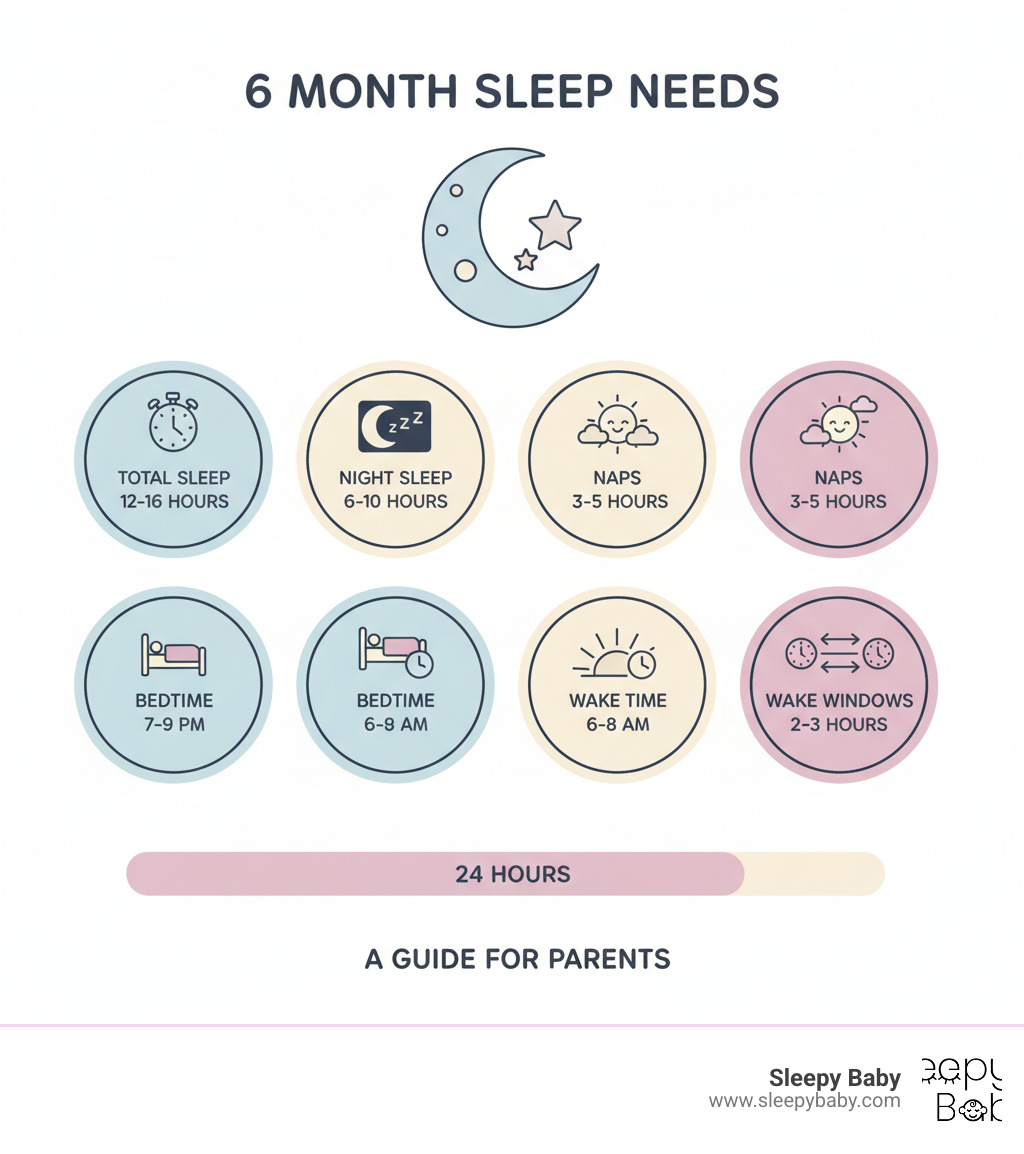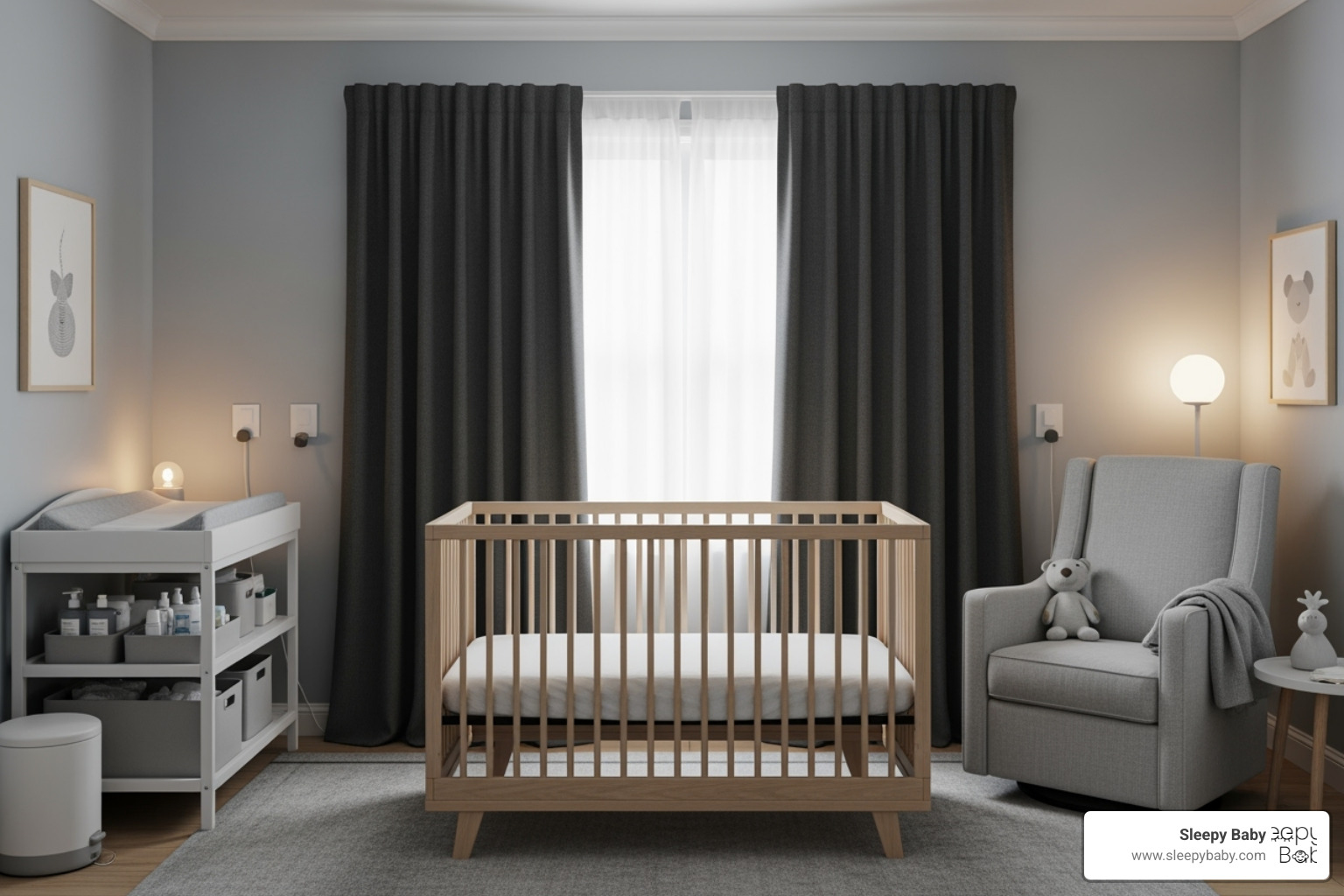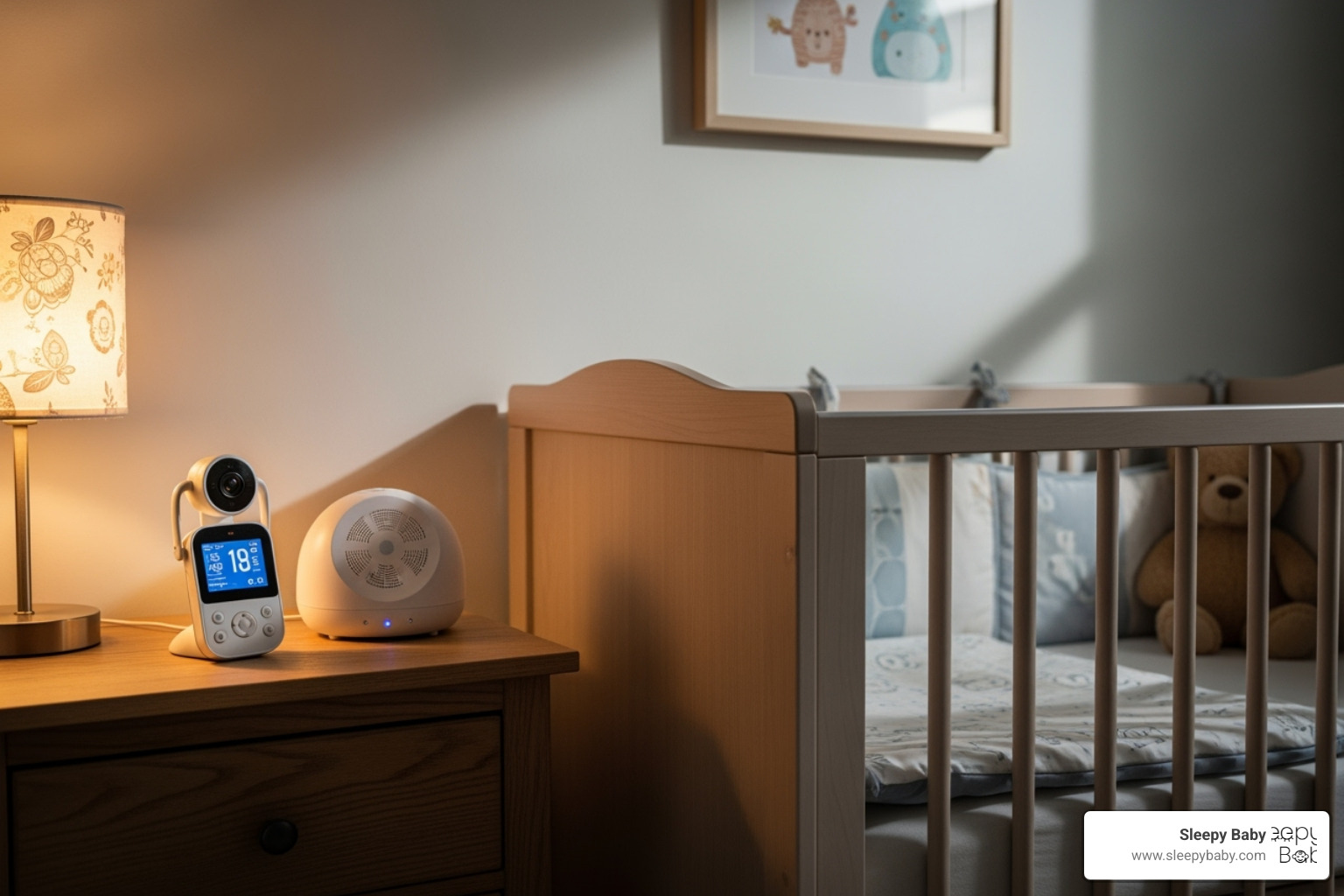Why Sleep Training at 6 Months Is a Game-Changer for Your Family
6 month old sleep training methods can transform exhausting nights into peaceful, restorative sleep for the whole family. If you're struggling with frequent night wakings, you're not alone. Research shows that up to 38% of 6-month-olds aren't sleeping for six consecutive hours at night.
The 6-month mark is the sweet spot for sleep training. Most babies are developmentally ready: their circadian rhythms are established, they can often sleep 6-10 hours without a feed, and their sleep cycles have matured. The goal is to help them get 12-16 hours of total sleep, including naps.
Popular 6 month old sleep training methods we'll explore include:
- Ferber Method (Graduated Extinction)
- Chair Method
- Pick-Up/Put-Down
- Cry It Out (Extinction)
- Fading Method
Successful sleep training leads to improved maternal mental health, better family functioning, and babies who learn valuable self-soothing skills. As one parent shared, "After months of deteriorating into #zombielife, we knew it was time for sleep training!"
I'm Gary Harutyunyan, a father who struggled with my own baby's sleep. I researched and tested countless methods, which led me to create the Sleepy Baby. It combines gentle rhythmic patting with soothing sounds to support families through this process.
This guide will walk you through everything from recognizing readiness signs to choosing the right method for your family.

Is Your 6-Month-Old Ready? Preparing for Sleep Training Success
Before diving into 6 month old sleep training methods, it's crucial to ensure your baby is ready. Starting at the right time makes all the difference between success and frustration. Just as you wouldn't teach a baby to walk before they can sit up, sleep training requires certain developmental milestones.
Signs Your Baby is Ready for Sleep Training
The window for sleep training typically opens between 4 and 6 months. By 6 months, most babies are developmentally ready to learn independent sleep skills.
- Age and Development: At 6 months, your baby's internal clock (circadian rhythm) has matured, meaning their body is primed for longer stretches of sleep at night.
- Healthy Weight: Get your pediatrician's blessing. They can confirm your baby is thriving and likely no longer needs middle-of-the-night calories. Most 6-month-olds can sleep 6-10 hours without a feed.
- Reduced Night Feeds: If your baby wakes but only takes a small amount of milk before falling back asleep, it's likely a sign of habit, not hunger.
- Emerging Self-Soothing Skills: Does your baby suck their thumb or rub their head on the mattress to calm down? These are early signs of self-soothing.
- Predictable Patterns: If your baby gets tired around the same time each evening, it shows their body is learning to regulate sleep.
A quick note on timing: Avoid starting sleep training during major disruptions like illness, travel, or heavy teething. For more on this, see our guide on the 6 month sleep regression: Signs every parent should know.
Creating the Perfect Sleep Environment
Your baby's room needs to be set up for sleep success. Thoughtful preparation is more important than expensive gadgets.

- Darkness: Use blackout curtains to make the room as dark as possible. Darkness signals to your baby's brain that it's time to sleep.
- Temperature: Keep the room between 68-72°F (20-22°C). A cool room is safer and more comfortable for sleep.
- A Safe Crib: The mattress should be firm and fit snugly. Ensure the crib meets current safety standards and is free of blankets, pillows, bumpers, or toys.
The Power of a Consistent Bedtime Routine
A consistent bedtime routine is a powerful cue that sleep is coming. Research shows that bedtime routines significantly improve sleep quality in young children. A calm, predictable routine of 20-30 minutes is perfect. A typical routine might include a warm bath, pajamas and a sleep sack, a final feeding (while awake), and a quiet story or lullaby. The key is to place your baby in their crib drowsy but awake, giving them the chance to practice falling asleep on their own.
Essential Sleep Safety Considerations
Safety is paramount, regardless of which 6 month old sleep training methods you choose.
- Back to Sleep: Always place your baby on their back to sleep to reduce the risk of SIDS. If they can roll both ways, it's generally fine for them to change positions on their own.
- Room-Share, Don't Bed-Share: The American Academy of Pediatrics recommends keeping your baby's crib in your room for at least the first six months.
- Wearable Blankets: Use a sleep sack for warmth and safety. A 2 way zipper Sleep Sack can make nighttime diaper changes easier without the risks of loose bedding.
A Guide to 6 Month Old Sleep Training Methods
Now that you've prepared the sleep environment, let's explore the various 6 month old sleep training methods. There is no single best solution; the right choice depends on your comfort level, your baby's temperament, and what you can apply consistently. Think of these methods as different parenting styles—some are gentle and gradual, while others are more direct. The goal is to find the best fit for your family.
Choosing the Right 6 Month Old Sleep Training Methods for Your Family
Consider your comfort level with crying, how much hands-on involvement you prefer, and your baby's personality. Some babies are soothed by check-ins, while others become more agitated. The most effective method is the one you can stick with.
| Method | Crying Level (Initial) | Parental Involvement | Typical Duration (to see progress) | Description |
|---|---|---|---|---|
| Cry It Out (CIO) | High | Low | 3-7 nights | You put your baby down awake and leave the room, allowing them to cry and self-soothe without any check-ins. This method is often the fastest, but can be emotionally challenging for parents. |
| Ferber Method (Graduated Extinction) | Moderate | Moderate | 3-14 nights | Involves putting your baby down awake and leaving the room, but returning at progressively longer intervals (e.g., 3, 5, 10 minutes) to offer brief verbal reassurance without picking them up. This provides comfort while still teaching independent sleep. As one doctor put it, "Yep! That's the best way! I tell parents all the time that they need to use the Ferber method..." More on the Ferber method. |
| Chair Method | Low to Moderate | High | 1-3 weeks | You sit in a chair next to the crib until your baby falls asleep. Over several nights, you gradually move the chair further away from the crib, eventually moving out of the room entirely. This offers a comforting presence without direct intervention. |
| Pick-Up/Put-Down | Low to Moderate | High | 2-4 weeks | When your baby cries, you pick them up to soothe them until they are calm (but not asleep), then immediately put them back down in the crib. This is repeated as many times as necessary. It's a very hands-on, gentle method that minimizes crying but can be quite time-consuming. |
| Fading Method | Low | High | Several weeks | This "no tears" approach involves gradually reducing the sleep associations your baby has. For example, if you rock your baby to sleep, you would slowly shorten the rocking time each night until they are placed in the crib drowsy but awake. This is the most gentle but also the slowest method. |
Gentle, Gradual Methods
If you prefer an approach with minimal tears, gentle methods are an excellent choice. They require more time and patience but can be just as effective.
- The Fading Method: This involves slowly reducing your involvement. For example, if you rock your baby to sleep, you gradually decrease the rocking time each night until they can be put down drowsy but awake.
- The Chair Method: This popular method provides a comforting presence. You start by sitting in a chair next to the crib until your baby sleeps, then move the chair further away every few nights until you are out of the room.
- The Pick-Up, Put-Down Method: This hands-on approach involves picking your baby up to calm them when they cry, then immediately putting them back in the crib once they are settled (but not asleep). This cycle is repeated as needed.
Methods with Timed Checks and Extinction
For families seeking faster results, or for babies who get more upset by frequent check-ins, these methods may be a better fit. Extensive research shows that sleep training does not cause long-term harm to babies.
- The Ferber Method: Developed by Dr. Richard Ferber, this method balances reassurance with independent learning. You put your baby down awake and return for brief, timed checks at increasing intervals (e.g., 3, 5, then 10 minutes), offering verbal comfort without picking them up.
- Cry It Out (CIO): Also known as extinction, this is the most direct method. After your bedtime routine, you leave the room and don't return until morning (or a scheduled feed). While emotionally difficult for parents, it is often the quickest method, with some babies learning to self-soothe within a few nights.
Navigating the Process: What to Expect and How to Succeed
Starting any of the 6 month old sleep training methods can feel nerve-wracking, but you're working with your baby's natural development. Their brains are ready to learn this new skill. Here’s how to steer the process and set yourself up for success.
How Long Does Sleep Training Take?
The good news is that most families see significant progress within three to seven nights. However, it can take up to two weeks for your baby to fully master independent sleep. The first few nights are almost always the hardest as your baby learns a new skill. Consistency is the key to faster results. Wavering or switching methods will only confuse your baby and prolong the process. Focus on gradual improvement rather than comparing your journey to others.
Handling Night Wakings and Naps
Even after sleep training, occasional night wakings can happen. The goal is to teach your baby to resettle without your help.
- Night Wakings: Have a clear plan. Unless you suspect hunger or distress, wait a few minutes before intervening. Many babies will fuss briefly and fall back asleep. When you do intervene, keep it brief and consistent with your chosen method. Our guide on why your 6 month old keeps waking up and how to fix it offers more strategies.
- Naps: Nap training can be trickier. Establish a short, consistent nap routine and pay close attention to wake windows, which are typically 2-3 hours at this age. Putting your baby down too early or too late can sabotage naps. Short naps are common; continue offering longer nap opportunities. Our guide on perfecting the 6 month old nap schedule can help.
Helpful Tools for Sleep Training
The right tools can make your sleep training journey much smoother.

- Baby Monitor: A quality monitor allows you to check on your baby without entering the room, giving them space to learn while giving you peace of mind.
- White Noise Machines: These block out household noises. While some older machines can be unsafe, modern safety-rated devices present white noise at safe, low-decibel levels. Some can even be positioned on the baby's chest for optimal sound delivery.
- Rhythmic Tapping Devices: Innovative sleep aids like our Sleepy Baby are game-changers. They provide gentle, consistent patting that mimics a caregiver's comforting touch. This technology offers hands-free soothing, helping your baby learn to sleep independently while still feeling comforted.
- Sleep Sacks: A 2 way zipper Sleep Sack is essential for keeping your baby warm and safe without the risks of loose blankets.
Common Mistakes to Avoid
Be aware of these common pitfalls to keep your efforts on track.
- Inconsistency: Switching methods confuses your baby. Commit to one approach for at least two weeks.
- Bad Timing: Avoid starting when your baby is sick, teething, or during travel.
- Creating New Sleep Props: Be careful not to replace one sleep association (like feeding) with another (like rocking).
- Giving Up Too Soon: The first few nights are often the hardest. Pushing through often leads to a breakthrough.
- Unrealistic Expectations: Every baby is different. Focus on your child's progress, not on others' success stories. For more guidance, see our article on mastering the 6 month old sleep schedule.
Frequently Asked Questions
As you steer 6 month old sleep training methods, it's normal to have questions. Here are answers to some of the most common concerns.
What are the benefits and drawbacks of different 6 month old sleep training methods?
Understanding both sides of sleep training helps you make an informed choice.
The benefits are significant:
- Better Sleep for Everyone: When your baby sleeps well, the whole family is more rested and patient.
- Improved Maternal Mental Health: Studies show sleep training can reduce symptoms of depression and anxiety in mothers, restoring a sense of confidence.
- Valuable Self-Soothing Skills: Your baby learns resilience and independence that will benefit them for years.
The potential drawbacks are mostly short-term:
- Emotionally Challenging: Hearing your baby cry is difficult, even when you know they are safe and learning.
- Crying is Involved: Crying is your baby's way of protesting change. It's normal but can be hard for parents.
- Inconsistency Causes Confusion: Starting and stopping can confuse your baby and prolong the process. It's crucial to stick to your chosen plan.
Importantly, extensive research has found no evidence that sleep training causes long-term harm to a child's emotional development or attachment to their parents.
How does sleep training a 6-month-old differ from other ages?
The 6-month mark is a sweet spot for several reasons:
- Compared to Toddlers: It's generally easier than training a toddler, who has a stronger will and can use stalling tactics like asking for more stories or water.
- Compared to Newborns: A 6-month-old is developmentally ready. Their circadian rhythms are established, and they no longer need frequent night feeds like a newborn does.
- Developmental Leaps: Be aware that 6-month-olds are mastering new skills like sitting and rolling, which can temporarily disrupt sleep. This is normal and usually passes quickly with consistency.
When should I talk to a doctor or sleep consultant?
It's okay to ask for help! Professional guidance can be a lifesaver.
- After Two Weeks: If you've been consistent for two weeks with no improvement, a sleep consultant can help troubleshoot your plan.
- If You Suspect a Medical Issue: Always consult your pediatrician if you think pain from reflux, allergies, or other medical issues is disrupting sleep. These must be addressed before sleep training can work.
- For a Personalized Plan: A certified sleep consultant can create a customized plan for your baby's temperament and your family's values.
- If You're Overwhelmed: Sleep deprivation is serious. Seeking support for your own mental health is a sign of strength. You can always talk to your healthcare provider about your concerns.
Conclusion: Your Journey to Better Sleep
Implementing 6 month old sleep training methods is a transformative step for your family. It's about giving your child the lifelong skill of independent sleep, leading to more restorative nights for everyone.
Remember the keys to success: ensuring your baby is ready, creating a safe and dark sleep environment, and above all, being consistent with your chosen method. The first few nights may be challenging, but the long-term benefits—for your baby's development and your own well-being—are immense.
Tools can make a world of difference. A baby monitor provides peace of mind, while white noise can mask disruptive sounds. This is where our passion at Sleepy Baby comes in. Our innovative rhythmic tapping devices mimic your comforting touch, providing hands-free soothing that helps your baby learn to sleep on their own while feeling secure.
At Sleepy Baby, our mission is to support families through this journey. Our portable, intelligent sleep aids are designed to extend a helping hand, because we believe every family deserves the gift of good sleep.
You are not just solving a short-term problem; you are investing in your family's long-term health and happiness. With the knowledge from this guide, you are equipped to handle this journey with confidence and love.
Explore our blog for more expert tips and guides on your baby's sleep journey.





